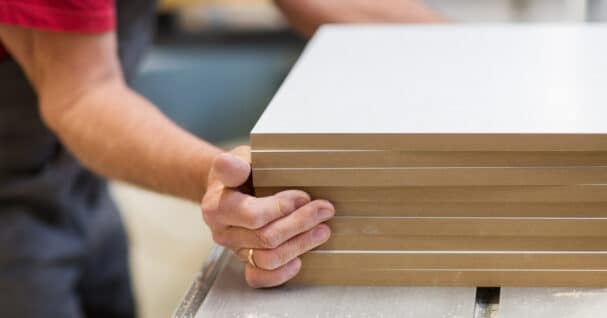
When you’re working in environments with high humidity or occasional moisture, not all materials will hold up. That’s where moisture-resistant MDF comes in. Whether you’re designing kitchen cabinets, building bathroom vanities, or outfitting commercial interiors, this durable board offers a practical and affordable solution. Let’s explore what makes it different from standard MDF and where it’s most useful.
What Is Moisture-Resistant MDF?
Moisture-resistant MDF, sometimes called MR MDF, is engineered to withstand damp or humid conditions better than traditional MDF. It’s made the same way as standard MDF — by compressing wood fibers with resin under heat and pressure — but with the addition of water-repellent agents.
One way to identify moisture-resistant MDF is by its distinctive green core, a visual indicator used in the industry to signal its water-repellent properties. While it’s not fully waterproof, it holds up much better in humid environments than standard MDF, which tends to swell or warp when exposed to moisture.
Moisture-Resistant MDF vs. Waterproof MDF
It’s important to understand that moisture-resistant doesn’t mean waterproof. Waterproof MDF board is a bit of a misnomer — most MDF products, even treated ones, aren’t designed for full water exposure. MR MDF resists humidity and occasional moisture contact, making it suitable for indoor use in wet areas. But for outdoor use or direct water contact, materials like marine-grade plywood or PVC panels are more appropriate.
Benefits of Moisture-Resistant MDF
Moisture-resistant MDF offers several advantages that make it a popular choice for both residential and commercial projects:
- Improved moisture tolerance helps prevent warping, swelling, or delamination in damp areas.
- Smooth surface allows for clean paint finishes or easy lamination.
- Cost-effective alternative to marine plywood or hardwood.
- Stable and strong, making it easy to machine, rout, and cut cleanly.
- Ideal for interior applications where occasional humidity is expected.
Whether you’re a builder or a designer, MR MDF gives you a versatile material that performs well in environments where standard MDF wouldn’t last.
Best Uses for Moisture-Resistant MDF
Kitchens
Kitchens are one of the most common areas where moisture-resistant MDF is used. Steam, spills, and high humidity are part of everyday life in a kitchen, and MR MDF stands up better to these conditions than standard boards. It’s commonly used for:
- Cabinet doors and interiors
- Wall paneling and trim
- Built-in shelving or storage
Its smooth surface is easy to paint or finish, making it ideal for modern kitchen design.
Bathrooms
Bathrooms are another space where humidity can pose a challenge. While MR MDF shouldn’t be used in areas exposed to standing water, it performs well in general bathroom applications such as:
- Vanity units and drawers
- Bathroom storage or linen cabinets
- Decorative paneling and trim
In these uses, moisture-resistant MDF outperforms standard MDF and gives you greater peace of mind over time.
Commercial Interiors
Moisture-resistant MDF is a go-to material for many commercial applications that require durability and a polished look. You’ll often find it used in:
- Office restroom partitions
- Breakroom cabinetry
- Restaurant or retail displays
- Wall linings in gyms, spas, or hospitality settings
Its durability and consistent surface make it an attractive choice for high-traffic interiors.
MDF vs. Plywood for Bathrooms
One common question is whether to use MDF or plywood in bathroom settings. The answer depends on the application:
- MDF offers a smoother finish, making it ideal for painted cabinetry and trim. Moisture-resistant MDF performs well in dry-to-moderate humidity areas.
- Plywood, especially marine or exterior-grade types, is a better choice for areas exposed to constant moisture or water contact, like subflooring or behind tiled shower walls.
If you’re looking for an affordable, easy-to-finish material for cabinets or vanity units, MR MDF is a strong candidate. For structural or high-exposure areas, plywood is often the better fit.
How to Work With Moisture-Resistant MDF
Moisture-resistant MDF works similarly to standard MDF but is slightly denser due to the added treatment. Here are a few tips:
- Use sharp tools to avoid chipping during cutting or routing.
- Always seal edges with primer or paint to enhance moisture resistance.
- Use moisture-resistant adhesives and finishes in high-humidity environments.
Proper finishing and installation go a long way in maximizing the durability of MR MDF.
What to Look for When Buying MR MDF
If you’re sourcing moisture-resistant MDF, be sure to:
- Look for the green core and product labeling indicating it’s moisture resistant.
- Check thickness and sizing for your intended use — cabinet-grade boards are often available in a variety of dimensions.
- Buy from a trusted supplier that offers high-quality, reliable products, like Forest Plywood.
You can view our moisture-resistant MDF product page for more details, or compare it to standard MDF panels to see which is best for your application.
Durable, Versatile, and Built to Last
Moisture-resistant MDF is a smart solution for a range of projects — from kitchen cabinetry to bathroom vanities to commercial interiors. It bridges the gap between affordability and performance, giving builders and designers a material that holds up well without breaking the budget.
Still have questions about which MDF to choose? Contact our team for expert guidance, or stop by one of our locations to see our full inventory in person. Forest Plywood is here to help you build with confidence.



